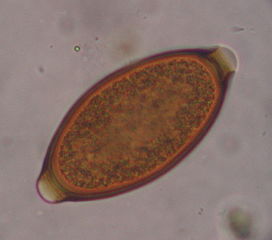With the warmer weather, unfortunately comes more
parasites. I thought we’d take a quick look at some of the different worms that
can affect our pets. The good news is most of these can be prevented and all of
them can be treated!
 |
| A great schematic of how heartworms are transmitted in dogs. (Image Source) |
First let’s start with heartworms. This is a worm that is
transmitted by mosquitos and can be found in the blood supply. So in this case,
checking a stool sample will give you no indication if your pet is affected. To
diagnose heartworm disease we have to draw blood. This is recommended yearly as
administering heartworm prevention to a heartworm positive dog can be risky. The
baby worms live in the blood stream but the adults typically set up shop in the
lungs and sometimes in the heart. As they grow and reproduce they cause damage
to the heart and lungs, so most patients will present with a cough or exercise intolerance.
Fortunately, there are preventatives available that can stop the development of
the worms. Most options are given to the pet monthly. Your veterinarian may
have different products available and be able to work with you on what will best
fit your pet’s needs. One additional thought is that heartworms do not just
affect dogs, but can also affect cats. There are preventatives available to
help keep cats safe. For more information on heart worms please visit the
following websites here and here.
 |
| Whipworm egg seen under the microscope. (Image Source) |
The next set of worms we will try to group together, as
they are diagnosed the same way. The main worms in this category include
roundworms, hookworms and whipworms. These are intestinal worms that can be
identified through regular screening of stool samples. One thing to remember is
that when we are looking at stool samples, we are looking to identify the eggs
of the worms that could be present. There are times where worms only shed the
eggs intermittently so a diagnosis could be difficult to obtain. Sometimes checking
several stool samples at different intervals will help us arrive at a
diagnosis. Most are obtained from ingesting something in the environment that is
carrying the worms. Hookworms and roundworms are also very commonly found in
most puppies typically transmitted from the mother. These can all be treated
with medications, however making sure the environment stays clean so they do
not continue to re-infest themselves is VERY important. Something to keep in
mind, is that many heartworm preventatives will also have some medications that
offer a level of prevention for the intestinal parasites as well. Not all
products will, so be sure to ask your veterinarian if the product you are using
will help decrease your pet’s risk. For more information on these parasites
please visit the following websites here, here and here. It is important to
identify if worms are present, not only for the health of your pet but also the
health of your family. There are cases where people can be affected by several
of these worms. This another reason why yearly stool screenings are
recommended.
 |
| Schematic of how pets can obtain tapeworms (Image Source) |
One final category of worms we commonly see include the
tapeworms. Now these are also seen in the stool, but they are not typically
obtained from the environment. Tapeworms infections usually occur after a pet
as ingested a flea. The life cycle of the worm is then completed inside the new
host. Even if you pet is on monthly flea prevention they are still at risk for
tapeworms as they could ingest a flea from the outside environment or even be
exposed to a rodent that is carrying the tapeworm. Fortunately most pets on
FLEA prevention will rarely have issues, but if they do there are medications
that can help eliminate the worms. Tapeworms are typically seen in the stool
and look like little pieces of rice, but they can also look like little sesame
seeds around the tail of your pet or where they like to sleep. Sometimes the
eggs can be difficult to find in a stool sample as they are very fragile and
can fall apart before we can identify them. The easiest way we make the diagnosis
is seeing the rice like segments of the worm in the stool. For more information
on tapeworms you can visit the following website here.
 |
| Remember many of these worms can be preventive with monthly flea and heartworm medication. (Image Source) |
This was just a very brief overview of some of the most
common worms we see in practice. The good news is many can be prevented before
our pets have any long term effects. You can always work with your veterinarian
on a proper deworming/ screening process specific for your pet’s needs.
No comments:
Post a Comment